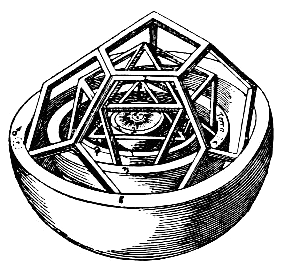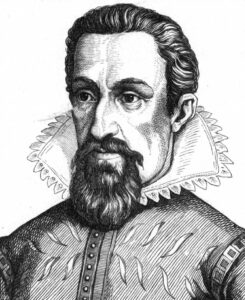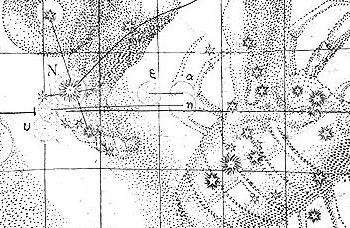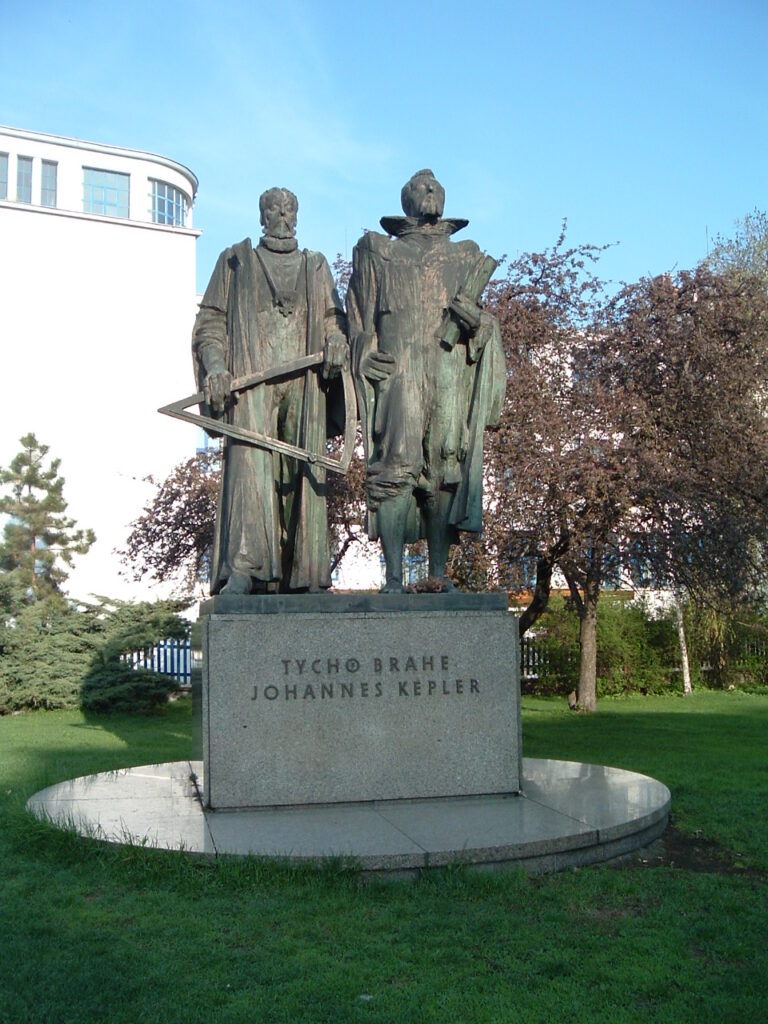In the early 17th Century, a religious man decided he was going to uncover the architecture of the universe itself. Using observations of the Heavens and a deep understanding of geometry, this man conjectured a world of harmonious design, where the secrets of God’s creation could be deciphered by anyone willing to use mathematics to look for them. In the course of his quest, this man managed to change our understanding of astronomy forever. His name was Johannes Kepler, and he would go down as one of the greatest scientists to ever live.
Born into a divided Europe, Kepler grew up during a time of unfathomable change. Witchcraft trials, religious war, and a scientific revolution were all pulling the continent apart. Yet Kepler managed to not just navigate through these changes but to do so while transforming science. He discovered laws of astronomy, changed our understanding of optics, pioneered crystallography, developed telescopes, and even wrote what’s likely the first work of science-fiction. Persecuted for his faith, misunderstood in his lifetime, this is the life of Johannes Kepler, the man who discovered the secrets of the universe.
Children of the Revolutions
When Johannes Kepler was born in 1571, it was into a Europe already reeling from two major revolutions. Half a century earlier, a man called Martin Luther had nailed his Ninety Five Theses to a church door, kicking off a century and a half of religious upheaval known as The Reformation. Twenty six years after that, in 1543, the astronomer Nicolaus Copernicus had proved the sun didn’t orbit the Earth, but the other way around, triggering an even bigger upheaval known as Scientific Revolution.

By the time Johannes Kepler first opened his eyes, these twin revelations were causing Europe to strain at the seams. Not that Kepler’s parents could’ve imagined he’d live long enough to see those seams rip wide open. The boy was weak, sickly. A prime candidate in those hard times for an early death. And die he nearly did. Before he was even five, Kepler came down with smallpox, a disease that left his eyesight damaged and his hands unable to properly function.
Luckily, though, it didn’t kill him. Instead, Kepler lived through his illness to see the sight that would change his life.
The Great Comet of 1577 was so bright it made the whole of Europe stop and gawp. Up in the Kingdom of Denmark, the astronomer Tycho Brahe – who we’re gonna meet again in a moment – watched the comet pass and knew it would transform his life’s work. For young Kepler, though, the Great Comet was even more important. It was this event that would one day make him into an astronomer.
But only after some false starts.
As a good Lutheran growing up in the Holy Roman Empire – a collection of several hundred states roughly analogous to modern Germany – Kepler wasn’t meant to be a mathematician. When he enrolled at the University of Tübingen in 1589, it was on the strict understanding that he would study theology, become a pastor and help spread Luther’s gospel.
The fact this didn’t happen is due entirely to Michael Maestlin.
Maestlin is one of those figures basically no-one today can name, but who wound up changing history. Kepler’s mathematics tutor, Maestlin was a private devotee of Copernicus – “private” because these were the days when saying the sun didn’t orbit the Earth could end with the religious authorities using you as an unwilling test subject for their shiny new thumbscrews.
But when Maestlin discovered Kepler loved astronomy, he broke cover long enough to lend him Copernicus’s De revolutionibus orbium coelestium libri vi. What Kepler read there blew his mind. In Copernicus’s heliocentric universe, Kepler saw not heresy, but the first glimpses of God’s harmonious design.
For Kepler, this was his Road to Damascus moment, the revelation that changed everything. From then on, he devoted his life to studying the stars.
It was the start of a journey that would take him not just across the Holy Roman Empire, but into more danger than this sickly teen could have ever believed possible.
The Road to Prague
In 1594, Johannes Kepler received an unexpected letter. Now 23, Kepler was on the verge of graduating university. Despite his devotion to astronomy, he still planned to become a pastor, because that’s just what you did in the late 16th century.
The letter changed all that.
Sent from the Austrian city of Graz, it invited Kepler to come and work as a math teacher. And, just like that, Kepler was able to throw his boring destiny away, and become the mathematician he’d always dreamed of being.
Well, almost.
Despite what the letter had promised, almost nobody in Graz attended Kepler’s classes. He was forced to take a second job as a calendar maker just to survive. But what Kepler’s life in Graz lacked in opportunities, success, or happiness, it more than made up for with spare time. Spare time in which Kepler could ponder some of science’s most pressing mysteries.
Before Copernicus had come along and dynamited thousands of years of human thinking, it was accepted that the planets were fixed to the Heavens, and that the Heavens rotated around the Earth. But now Copernicus had shown Earth was moving around the sun, all sorts of weird questions had arisen.
Clearly, Earth wasn’t fixed to anything. It was just kinda floating along. So what made it float? What made the other planets move?
It was while daydreaming in one of his near-empty classes in 1595 that Kepler felt a lightbulb go ping! above his head. If the planets had a regular orbit around the sun, then surely this was because the sun itself was affecting them with some kind of force. Today, we’d call that force “gravity”, but Kepler was living about 50 years before Isaac Newton was even a lustful twinkle in his father’s eye. So he called it magnetism.
Still, it was the first time anyone in Europe had even come close to understanding what made our solar system tick.
But Kepler went even further than just pontificating about the sun. Curious about the space between the planets, he hypothesized that each gap must correspond to one of the Platonic solids: the tetrahedron, cube, octahedron, icosahedron, and dodecahedron. When his calculations seemed to bare this out, he declared he’d uncovered God’s architecture.
So, this might sound a little cuckoo to modern ears. Magic shapes? God’s architecture? Whaaaa…? Well, we need to remember the era Kepler was living in. This was an era before pure mathematics. An era in which you could say the sun orbited the Earth and not only not have people snigger at you, but then have them imprison your neighbor for disagreeing.
What Kepler’s work did was suggest the universe could be understood through math. That there was a scientific way of thinking about the Heavens beyond simply saying “God did it.”
It’s that simple thought that would turbocharge the Scientific Revolution. Kepler published his ideas in 1597, the very same year he married his first wife. Not long after, he began writing to Tycho Brahe. Remember Brahe? The Danish guy who saw the Great Comet and realized it would transform his career?
Well Kepler became his pen pal, just as Brahe was in the process of moving his work to Prague. It was a relationship that would soon save Kepler’s life. In 1599, the religious tensions simmering across Central Europe between Catholics and Lutherans boiled over in Graz.
The city’s Catholics rioted, attacking Protestants.
For the Lutheran Kepler, this was a “hoo, boy. Better get outta here,” moment. The trouble was, he had nowhere to go. His religious buddies back at Tübingen University had read his book and decided he was a Copernicus-loving heretic who wasn’t allowed to hang out with them anymore.
Just as it was starting to look like Kepler might find himself being tarred and feathered by angry Catholics, Brahe threw him a lifeline.
“Hey, I’ve got a crazy idea,” he basically said, “why don’t you come work for me in Prague?”
And that’s how, in the dying days of the sixteenth century, Johannes Kepler found himself joining the legendary court of Rudolf II.
The Court of the Golem
If you were alive and into spooky stuff in 1600, there was nowhere better to be than Rudolf II’s Prague. The Holy Roman Emperor was obsessed with everything occult. The legendary alchemist John Dee worked for him, as did Rabbi Loew, the man said to have created the Golem. Not that Rudolf distinguished between crackpot mysticism and actual science.
He supported alchemists and astrologers, but he also astronomers and mathematicians.
And one of those astronomers just happened to be Tycho Brahe. Brahe had arrived in Prague the year before, to take the title Imperial Mathematician. His mission was to undertake a new set of planetary observations and then create a table from the results that could predict where anything in the night sky would be on any future date.
Such tables had existed before, but they’d been plagued by poor data. Brahe was determined to make the most accurate table in history.

Unfortunately, history is exactly what Tycho Brahe was about to become.
On October 24, 1601, Brahe died. Rather than halt his work, Rudolf II simply handed it to Brahe’s new assistant. Which is how Kepler suddenly found himself not just saddled with the title Imperial Mathematician and a difficult job to finish, but also with access to the scientific equivalent of magic pixie dust.
In his lifetime, Brahe had been a guy who didn’t like to share. Among the things he didn’t like sharing were his astronomical observations, the most-accurate in human history. So when Kepler inherited Brahe’s work, he also got his hands on these observations. This data would be the key that helped unlock Kepler’s greatest discoveries.
For the next decade, Kepler slaved away in Prague, making new discoveries like a man possessed.
In 1604, for example, his attempt to figure out the best way to observe an eclipse sent him down a rabbit hole that ended in discovering how light travels through the human eye. Remember in science class, when you first found out that the human eye actually projects stuff onto your retinas upside down and your brain flips the image the right way up again?
Well, Kepler was the first to discover that. He then used this work to design highly improved eyeglasses. The same year he was working on optics, Kepler also became the first to observe what he called a “new star” in the sky. Actually, we know now it was the last recorded supernova in the Milky Way. Many years later, Kepler’s observation would help prove the Earth isn’t the center of the universe.
A few years later, in 1608, he wrote Somnium – or The Dream in English – possibly the first work of science fiction.
But it was the book Kepler published in 1609 that really changed the world. Astronomia Nova grew out of Kepler’s observations of Mars’s orbit. After tracing it across the sky for years, he finally clicked that the complex, twisting trail we see from Earth is because Earth is also moving through space.
By deploying what in the 1600s must’ve seemed like an insane thought experiment, Kepler managed to show what Earth’s own orbit would look like from Mars. From there, it was just a small step to prove that Mars’s orbit must be elliptical. It was the first time anyone had figured out what a planet’s orbit actually looked like. And it was from here that Kepler drew his First Law: that the planets have elliptical orbits, with the sun as one of the foci.
It’s also from here that he drew the Second of his Three Laws, which is pretty difficult to explain, but basically gives you a way to measure the speed any planet is traveling around the sun.
As for the Third Law…
Well, we’ll get back to that. When Kepler published these findings in his Astronomia Nova in 1609, he impressively included all his raw data – today something that’s a given where science is concerned. At the time, though, it was almost like a dare for his critics. A way for Kepler to say: “oh, you think I’m wrong, do you? Well you study the data then, and show me where I’m wrong!”
The Astronomia Nova was a monumental achievement, one that cemented Kepler’s claim to greatness.
Unfortunately, 1609 was also the moment Kepler’s world finally began to split apart.
The Religious Problem
Back in 1555, the Holy Roman Empire had managed to stop the continent exploding with something called the Peace of Augsburg. After Martin Luther did his thing, the Empire had transformed into a gigantic pressure cooker, with Catholics and Lutherans threatening to unleash Holy War on one another.
The Peace had released some of that pressure by removing the requirement for states in the Empire to be Catholic. Instead, each territory’s ruler could choose for themselves whether to be Catholic or Lutheran and no-one else would interfere. But the Peace was just a temporary fix, a quick release of some steam.
Inside individual states, pressure was still rising as the growing popularity of Protestantism collided with the often-Catholic elite.
In Bohemia, the Catholic Rudolf II had tried to solve this by signing the Letter of Majesty. An attempt at compromise, it allowed Bohemia’s protestant nobles to build their own churches and worship how they wished. Unfortunately, it was this very act of compromise that would ensure the pressure cooker of Europe finally exploded into the Thirty Years’ War.
Not that Kepler noticed any of this.
As the new decade dawned, he was still beavering away in Prague, still making discoveries. In 1610, for example, Galileo used the first telescope to discover Jupiter’s moons Io, Callisto, Europa, and Ganymede – now know as the Galilean Moons. Their existence was such a controversial discovery that most people simply refused to believe it, claiming the telescope must be causing optical illusions.
So Kepler sat down and wrote another book on optics, which not only proved Galileo couldn’t be seeing things, but also described how to build a vastly more powerful telescope. If it’s starting to sound like Kepler could do just about anything he put his mind to, you haven’t heard the half of it.
The following winter, 1611, he was inspired to do a short study of snowflakes.
Not only did he become the first person in history to observe that all snowflakes are unique, the resulting pamphlet has been called the earliest work on crystallography. Anyone else out there feeling like an underachiever right now? But even as Kepler kept churning out discovery after discovery, storm clouds were gathering on the horizon. The same year that Kepler was writing about snowflakes, Rudolf’s younger brother Matthias forced the Emperor to abdicate at swordpoint.
From the moment he took the throne, the hardcore Catholic Matthias made it clear that he wasn’t going to honor any letters giving legal rights to Protestant scum. Suddenly, the Lutheran Kepler was living in a city that officially hated Lutherans.
It was Graz 2.0. And, once again, Kepler had no way out.
As 1612 got underway, Kepler began searching frantically for an exit from Prague. He wrote again to his old university, but they were all like “Nah, sorry dude. We couldn’t possibly hire a guy who thinks the Earth orbits around the Sun. People would think we were crazy.”

If that wasn’t bad enough, that same year Kepler’s wife died of spotted fever.
Just as Kepler was getting desperate, the city of Linz came to his rescue. They would create the position of district mathematician just for him, provided he used his time in the city to finish Brahe’s tables. With no other options, Kepler accepted.
He got out just in time.
Five years later, in 1617, Prague cracked down hard on its Protestants. The churches opened under Rudolf II were closed, non-Catholics subjected to harassment. For a year, the Protestants tried to put up with these indignities. Then, in 1618, they finally snapped. On May 23, a group of Protestants stormed into Prague castle, grabbed three Catholics and hurled them out a high window.
The Defenestration of Prague is famous today not for its death toll – all three Catholics survived after landing in a pile of manure – but for what it started. The defenestration was the opening salvo in the Thirty Years’ War, three decades of religious violence that would destroy central Europe and leave over 8 million dead.
And Johannes Kepler was about to get caught right in the middle of it.
War and Witchcraft
If we were to try and explain the Thirty Years’ War, it would take about, well, thirty years and leave us all with very sore brains.
To put it in its crudest terms, just know that it was a religious war that quickly grew beyond religion, and would ultimately involve not just the many states of the Holy Roman Empire, but also France, Spain, Sweden, the Netherlands, Poland, the Ottoman Empire, the Habsburg Lands, England, Scotland, Russia, and pretty much just any nation that happened to be passing by and felt like joining this Royal Rumble.
Oh, and because the war was so big, so long, and so vicious, it also created the ideal conditions for outbreaks of plague, which in turn created the ideal conditions for witchcraft panics, which in turn led to some of the largest mass-executions for witchcraft in human history. So, yeah. The Thirty Years’ War. Not a fun time to be alive in Central Europe.
Sadly, Central Europe was exactly where Kepler was.
By 1619, Linz – like Graz and Prague before it – was paralyzed by anti-Protestant riots. As a guest of the city, Kepler was allowed to stay. He and his new family – he’d married local lass Susan Reuttinger soon after arriving in 1613 and they now had three children – were officially protected.
But unofficially? Unofficially, the family had to deal with prejudice every single day.

In such circumstances, it’s almost a wonder Kepler got any work done. Yet somehow he managed. That same year Kepler published his Third Law, which states that squaring the length of any planet’s orbit – in other words, the length of its year – and dividing that by its distance from the sun cubed will return a constant number.
It was a powerful mathematic insight. But it was also overshadowed by events in Kepler’s life.
Remember the book Somnium Kepler published back in 1608? The one we said might be the first work of science fiction. Well, we didn’t mention it at the time, but Somnium includes a little side story, one about a son who is a scientist, and a mother who is a witch. In 1620, life began imitating Kepler’s art in the darkest way.
That year, Kepler’s own mother was imprisoned for witchcraft.
Witchcraft accusations during the Thirty Years’ War weren’t to be taken lightly. This was the same era as the Wurzburg Witch Trials, in which hundreds of people were burned at the stake. Kepler knew he had to save his mother, so he dropped what he was doing and returned at once to organize her defense.
The resulting trial would eat up over a year of his life.
To hear the story now is actually all sorts of impressive. Kepler approached the case like he did his scientific work, using a deep analysis of the raw documents to forensically examine the prosecution’s claims. It was a battle between science and superstition. A case in which one side used rational arguments, while the other talked about demons and women turning themselves into cats.
Incredibly, science won.
After 14 months manacled in a cell, the threat of torture looming over her, Kepler’s mother was set free, thanks entirely to her son’s efforts. For Kepler – heck, for rationality – this was a huge victory. But it was one that came at a price. For over a year, Kepler’s scientific work had been put on hold. The trial had also left him in dire need of money, money the city of Linz wasn’t willing to pay.
Not long after the trial ended, Kepler’s Linz home was requisitioned and turned into a troop garrison. In 1625, the Catholics running the city confiscated his entire library and forced his children to start attending Mass.
Finally, in 1626, Kepler and his family left Linz for good.
By now they were broke and on the verge of destitution. Ever the optimist, Kepler tried heading back to Prague and asking the treasury for unpaid wages Rudolf II had owed him, but they simply laughed him out the city. It was a bleak time, not just for Kepler, but for the whole of Europe.
But the astronomer wasn’t done yet.
He still had one last moment of greatness to come.
Into Eternity
It had been 1599 when Rudolf II first called Tycho Brahe to his court to prepare new astronomical tables. This was years before Kepler described his Three Laws. Years before his discovery of Mars’s orbit, before the Defenestration of Prague, before the Thirty Years’ War. In that time, Brahe and Rudolf had both died. The continent had split apart.
But Kepler hadn’t forgotten what he was meant to be doing. Hadn’t forgotten the promise he made, so long ago.
In 1627, Kepler finally published Brahe’s finished tables. Known today as the Rudolphine Tables, they were the most accurate tables for predicting the movement of the planets in human history. They were based not just on Brahe’s jealously-guarded data, but also on Kepler’s own observations.
In fact, his Three Laws were baked into the Tables, underlying every calculation Kepler had performed.
If his Laws were real, the predictions in the Tables would be borne out. And, luckily, there was a major one coming up that everyone could check them against. In 1631, Mercury was scheduled to transit across the sun. Sadly for our story, Kepler wouldn’t live to see himself vindicated. On November 15, 1630, Johannes Kepler passed away in the city of Regensburg. Around him, the Thirty Years’ War continued to rage, a pointless howl of destruction consuming Europe.
Even in death, Kepler wouldn’t escape it. At some point, a rampaging army destroyed the cemetery he was buried in. The location of his body is now lost to history.
But even as Europe tore itself apart, the first rays of hope were beginning to glimmer. In 1631, Mercury completed its transit across the sun, exactly as Kepler’s Tables had predicted it would. With Kepler’s work clearly on the mark, it started raising questions, one of which would eventually come to greatly trouble a young British man. About fifty years later, long after the Thirty Years’ War had finally ended, Isaac Newton found himself pondering Kepler’s Tables.
If it were possible to predict the movements of planets so accurately, there must be some force guiding them. Newton disagreed with Kepler’s theory about a magnetic sun. So he set about discovering just what this mysterious force could be.
From these musings would come the discovery of gravity.
But while his influence on Newton may be Kepler’s biggest claim to fame, there are other ways his work lasted. Just take a look at Kepler’s Conjecture, a 1611 theory on the stacking of cannonballs that wasn’t proved until 1998, nearly 400 years later. But perhaps the most important aspect of Kepler’s work is the thinking that underlay it all. Kepler was one of the first to look at the night sky and see not some unknowable mechanism at work, but a divine plan that was both beautiful and capable of being understood by humans.
While Kepler may have been more explicitly religious than most scientists today – he actually referred to himself as a prophet at one point – that idea of a universal language, of an existence we can understand through mathematics, is still relevant.
Kepler may have died before he could see his life’s work be proved right. But his name will continue to echo across history for centuries to come.

Tycho és Kepler szobra Prágában, CC BY-SA 3.0
Sources:
https://www.thoughtco.com/johannes-kepler-astronomy-4072521
https://www.nasa.gov/kepler/education/johannes
https://www.britannica.com/biography/Johannes-Kepler
https://www.bbc.co.uk/programmes/b085xpzf
Mother witchcraft trial: https://www.theguardian.com/books/2015/oct/21/the-astronomer-and-the-witch-johannes-kepler-mother-katharina-witch-trial
Kepler’s supernova: https://www.smithsonianmag.com/smart-news/how-1604-supernova-presented-challenge-astronomers-180965138/
Defenestration of Prague: https://www.britannica.com/event/Defenestration-of-Prague-1618
Thirty Years War: https://www.history.com/topics/reformation/thirty-years-war



